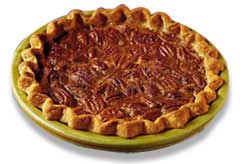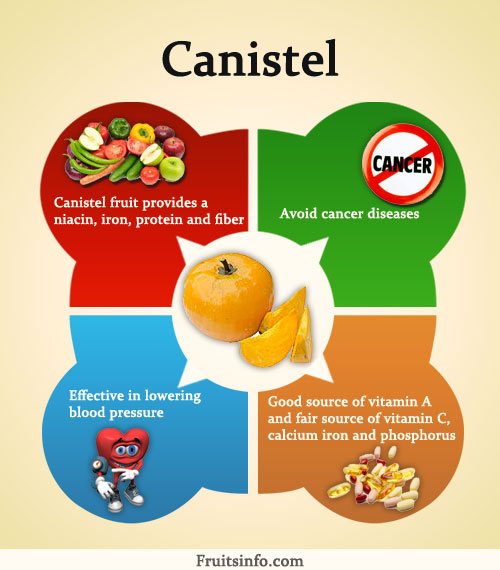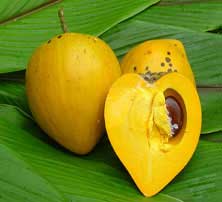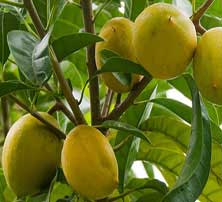 Full List of Fruits
Full List of Fruits  Canistel Fruit
Canistel Fruit
CANISTEL FRUIT
A Canistel fruit is a glowing yellow, waxy skinned fruit with a flesh that has the consistency of a hard-boiled egg yolk. Highly superior in the tropics, the canistel is seldom grown in the United States. Fruits can be highly variable in size and shape-ranging from round to pointed and ovaloid.
Appearance-Canistel is often referred to colloquially as "eggfruit".. When ripe, it is said to have a texture similar to that of a thoroughly cooked egg yolk. The meat of the fruit is sweet and edible raw. The exterior of a canistel fruit is a polished skin that, upon ripening, varies in yellow color and orange tones. Canistel fruit is soft, rather than hard, and it is not mostly juicy. Fruit insides are a few large polished black or dark brown seeds. While canistel fruits are not available in most markets in North America, they are available in Florida.
Taste-The fruit has a color of orange to yellow thin skin, and the flesh is dry like a boiled egg yolk. They are usually eaten fresh, used for cooking, pies, and they have a excellent taste in ice cream. In milk shakes they taste like eggnog. They are very related in taste to the Lucuma from Andean countries. It has a sweet taste and is a raw edible fruit to eat. The outside of the fruit having a different taste when compare to inside the seed film.
Look-The exterior of a canistel fruit is a polished skin that, upon ripening, varies in yellow color and orange tones. Canistel fruit is soft, rather than hard, and it is not mostly juicy. Fruit insides are a few large polished black or dark brown seeds. Some have likened canistel fruits to persimmons. The spindle-shaped form a eggfruit was the common strain in the Bahamas for many years, at least as far back as the 1920's. The rounded, broader form began to appear in special gardens in the 1940's, and the larger types were introduced from Florida in the 1950's.
 Canistel fruits is a just like juicy fruit and it is very popular and tasty fruits in corresponding area's. Some Floridia people were enjoy the fruit with salt, pepper and lime or lemon juice or mayonnaise, either fresh or after light baking for to taste. The pureed flesh can be used in custards or added to ice cream mix just before freezing. A rich milkshake, or "eggfruit nog", is made by mixture's of ripe canistel pulp, milk, sugar, vanilla, nutmeg or other seasoning in an electric mixer.
Canistel fruits is a just like juicy fruit and it is very popular and tasty fruits in corresponding area's. Some Floridia people were enjoy the fruit with salt, pepper and lime or lemon juice or mayonnaise, either fresh or after light baking for to taste. The pureed flesh can be used in custards or added to ice cream mix just before freezing. A rich milkshake, or "eggfruit nog", is made by mixture's of ripe canistel pulp, milk, sugar, vanilla, nutmeg or other seasoning in an electric mixer.
 Good source of vitamin A and niacin, fair source of vitamin C, calcium iron and phosphorus. Use fresh and in ice cream and desserts.
Good source of vitamin A and niacin, fair source of vitamin C, calcium iron and phosphorus. Use fresh and in ice cream and desserts.
 The star of the meal was sweet kale cooked simply with olive oil, garlic and chicken stock. The match-up pitted familiar vegetable, easy preparation and stellar results vs. exotic fruit, involved preparation and acceptable results.
The star of the meal was sweet kale cooked simply with olive oil, garlic and chicken stock. The match-up pitted familiar vegetable, easy preparation and stellar results vs. exotic fruit, involved preparation and acceptable results.
Canistel trees grow best in all tropical and warm of subtropical climates at altitudes below 4,500 ft, it requiring periodic rain. Trees are also moderately cold tolerant, however young trees can be damaged or killed at temperatures of 29°F and mature trees at 23°F. Canistel trees can even survive and tolerant excessively wet or flooded conditions for several days, however crop production can be impacted.
Trees are in however tolerate moderately windy conditions, and trees pruned to limit their size and allow for wind movement have survived hurricane-force winds without toppling. Established canistel trees can also survive long periods of drought, although impacts the fruit size during such periods.
 Planting the tree correctly is very important for successfully establishing growing and growing a strong, productive trees.
Planting the tree correctly is very important for successfully establishing growing and growing a strong, productive trees.
 Young Canistel trees need to be fertilized a every couple of months in the first year, starting with around 100 grams of fertilizer and increasing to around 500 grams per tree.
Young Canistel trees need to be fertilized a every couple of months in the first year, starting with around 100 grams of fertilizer and increasing to around 500 grams per tree.
 Periodic pruning of canistel trees can keep trees at a manageable height. Young newly planted canistel trees should be planted and left to grow during their first year so that they can establish themselves quickly. The following year in spring, trees should be trimmed back to encourage branching along the main trunk to encourage the formation of evenly spaced branches.
Periodic pruning of canistel trees can keep trees at a manageable height. Young newly planted canistel trees should be planted and left to grow during their first year so that they can establish themselves quickly. The following year in spring, trees should be trimmed back to encourage branching along the main trunk to encourage the formation of evenly spaced branches.
Nutritional Value:
Fruit is edible after eated from our hand and continue to laced with lime or lemon juice. Rich in niacin and carotene with a fair amount of vitamin C. In other countries, fruit used for jams, marmalades and flavoring for ice cream. A basis of vitamin C and calcium, Canistel fruit provides a niacin, iron, protein and fiber. There are 59 calories from average fruits. To avoid cancer diseases, continuesly five days eating of rambutan fruits.. A recent study found eating nine or ten daily of fruits and vegetables of rambutan family, were effective in lowering blood pressure.
Antimitotic: Study yielded six stilbenes and six flavonoid glycosides. Stilbenes have been shown to exhibit a wide range of biologic activities: anti-HIV, antitumor, antiinflammatory, antimicrobial and hepatoprotective. The distilbene ampelopsin B was found to arrest mitosis in a cell-based primary screen.
Antibacterial: Study on the stem of Pouteria campechiana showed slight activity against E coli and P aeruginosa, the fungi C albicans and T mentagrophytes. They were inactive against S aureus, B subtilis and A niger
138.8 Calories
Like most fruits, canistel fruits are more rich in a number of vitamins varieties and nutrients. They are mainly rich in carotene and niacin. They can also having a common, many food scientists and nutritionists feel that they are a very healthy food, and should be integrated into the diet if possible.
100g of Canistel flesh contains about 140 calories, 1.7g protein, 0.1g of fat, 37g carbohydrates, 37mg phosphorus, 58mg Vitamin C.Medicinal Uses
In 1971, a pharmaceutical company in California was exploring a derivative of the seed of Pouteria sapota which seemed to be active against seborrheic dermatitis of the scalp. Since they were having difficulty in procuring sufficient seeds for study, I suggested that they test the more readily available seeds of the canistel. They found these acceptable and were pursuing the investigation when last heard from.
| Nutritive value per 100 g of Canistel | ||
| Principle | Nutritive value | |
| Protein | 1.68 g | |
| Moisture | 60.0 mg | |
| Thiamin | 0.17mg | |
| Fat | 0.13 mg | |
| Carbohydrates | 39.69 mg | |
| Phosphorus | 37.3 mg | |
| Calcium | 26.5 mg | |
| Iron | 0.92 mg | |
| Niacin | 3.72 mg | |
 Canistel Recipe
Canistel Recipe
1.CREME DE CANISTEL ICE CREAM
- 1 cup canistel pulp
- 1/4 cup blanched almonds
- 2 cups milk
- 2/3 cup heavy cream
- 3 egg yolks
- 1/2 cup sugar.
Method:
Add the canistel, milk and heavy cream to a bowl and mix thoroughly together to a smooth mixture.
In separate a bowl, mix the egg yolks and sugar until light and fluffy. Add the Canistel mixture and mix well with wooden spoon. Return the mixture to the saucepan. Stir over medium-low heat until the custard thickens and coats the back of a spoon, do not boil.
Strain custard into a clean bowl and refrigerate until cold. Process custard in ice cream maker according to manufacturer's instruction. Transfer to covered container and freeze until firm.
2.CANISTEL PIE
- 1 1/3 cups mashed canistel
- 1 teaspoon lime juice
- 2/3 cup brown sugar
- 2 beaten eggs
- 1/2 teaspoon salt
- 1 1/4 cups low-fat evaporated milk
- 1/4 teaspoon nutmeg
- 1-9 inch pie crust
- 1 teaspoon cinnamon
Mix dry ingredients first, add remaining ingredients, except pie shell. Pour into unbaked pie shell and bake at 230 degrees C for 10 minutes. Reduce heat to 120 degrees C and continue baking about 50 more minutes. Serve warm or chilled, with whipped cream.





















